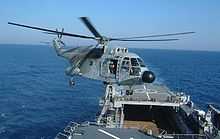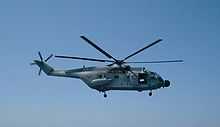Aérospatiale Super Frelon
| Role | Heavy-lift military Transport helicopter |
|---|---|
| Manufacturer | Aérospatiale |
| First flight | 7 December 1962 |
| Introduction | 1966 |
| Retired | South African Air Force 1990 French Aviation Navale 2010 |
| Status | Limited service |
| Primary user | People's Liberation Army |
| Produced | 1962-1970 |
| Number built | 99 |
| Developed from | SNCASE SE.3200 Frelon |
| Developed into | Avicopter AC313 |
The Aérospatiale SA 321 Super Frelon, (Super Frelon - Super Hornet) is a three-engined heavy transport helicopter produced by Aérospatiale of France. The helicopter is still in use in China where the locally produced version is known as the Z-8.
Development

The SA-3210 Super Frelon was developed by Sud-Aviation from the original SE-3200 Frelon. Sikorsky was contracted to supply the design of a new six-bladed main rotor and five-bladed tail rotor. Fiat supplied a design for a new main transmission. The first flight of the Super Frelon was December 7, 1962. A modified prototype Super Frelon helicopter was used on July 23, 1963 to break the FAI absolute helicopter world speed record with a speed of 217.7 mph.[1]
Both civilian and military versions of the Super Frelon were built, with the military variants being the most numerous by far, entering service with the French military as well as being exported to Israel, South Africa, Libya, China and Iraq.
Three military variants were produced: military transport, anti-submarine and anti-ship.
The transport version is able to carry 38 equipped troops, or alternatively 15 stretchers for casualty evacuation tasks.
The Naval anti-submarine and anti-ship variants are usually equipped with a navigation and search radar (ORB-42), and a 50 metre rescue cable. They are most often fitted with a 20 mm cannon, counter-measures, night vision, a laser designator and a Personal Locator System. It can also be refueled in flight.
Operational history
China

China acquired 13 Super Frelon SA321 naval helicopters in 1977-78. These helicopters came in two variants: anti-submarine warfare (ASW) and search and rescue (SAR) versions. The Super Frelon was the first helicopter of the PLA to be capable of operating from the flight deck of surface vessels. China also produces the Super Frelon locally under the designation Z-8 (land or ship based ASW/SAR helicopter). The Super Frelon remains operational with the PLA Navy in 2014.
Since the early 1980s, the Super Frelons have been frequently used by the PLAN for shipborne ASW and SAR operations. For ASW missions, the Z-8 is equipped with a surface search radar and a French HS-12 dipping sonar while carrying a Whitehead A244S torpedo under the starboard side of the fuselage. The aircraft were also used to ferry supplies from replenishment ship to surface combatants, and transport marines from the landing ship to the shore. A naval SAR version called the Z-8S with upgraded avionics, searchlight, FLIR turret and a hoist flew in December 2004. Another rescue variant with dedicated medivac equipment onboard was also developed for the Navy as the Z-8JH.
The Z-8A version was developed as an army transport variant and certified in February 1999. Two Z-8As were delivered to the Army for evaluation in 2001, but it decided to purchase more Mi-17V5s. Only one batch of about six Z-8A were delivered to the Army in November 2002, with the nose weather radar and side floats retained. Starting in 2007, the PLAAF also acquired dozens of upgraded Z-8Ks and Z-8KAs for SAR missions; they were equipped with a FLIR turret and a searchlight underneath the cabin, plus a hoist and a flare dispenser.
China also developed a domestic civil helicopter variant of the Z-8, the Avicopter AC313. The AC313 has a maximum takeoff weight of 13.8 tonnes and can carry 27 passengers, It has a maximum range of 900 km (559 miles).[2]
France
In October 1965 the SA321G ASW helicopter joined the French Aeronavale. Apart from ship-based ASW missions, the SA321G also carried out sanitisation patrols in support of Redoutable class ballistic missile submarines. Some aircraft were modified with nose-mounted targeting radar for 'Exocet' anti-ship missiles. Five SA321GA freighters, originally used in support of the Pacific nuclear test centre, were transferred to assault support duties.
In 2003, the surviving Aeronavale Super Frelons were assigned to transport duties, including commando transport, VertRep and SAR.
The SA321G Super Frelon served with Flottile 32F of the French Aviation navale, operating from Lanvéoc-Poulmic in Brittany in the Search and Rescue role. They were retired on 30 April 2010, replaced by two Eurocopter EC225 helicopters purchased as stop-gaps until the NHI NH90 came into service in 2011-12.[3][4]
Iraq
Designated the SA321H, a total of 16 Super Frelons were delivered from 1977 to the Iraqi air force with radar and Exocets. These aircraft were used in the Iran-Iraq conflict and the 1991 Gulf War, in which at least one example was destroyed.
Israel

Israel ordered 12 helicopters in 1965 to provide her air force with a heavy lift transport capability. The first aircraft arrived on April 20, 1966, to inaugurate 114 Squadron operating out of Tel Nof. Four helicopters had arrived by the start of the 1967 Six Day War, during which they flew 41 sorties. The aircraft saw extensive service during the War of Attrition, participating in such operations as Helem, Tarnegol 5 and Rhodes. [5]
The type was once again in service during the Yom Kippur War, following which Israel replaced the original Turbomeca Turmo engines with the 1,870shp General Electric T58-GE-T5D engine. The Super Frelons also took part in the Israeli invasion of Lebanon in June 1982[5] and were finally retired in 1991.
Libya
Six radar-equipped SA-321GM helicopters and eight SA321M SAR/transports were delivered to Libya in 1980-81.[6]
South Africa
The South African Air Force ordered 16 Super Frelon helicopters and used them in counter-insurgency fighting and in the South African Border War in Angola. The Super Frelons were withdrawn from service in 1990, and replaced by the Puma and the Oryx.
The SAAF discovered that the Super Frelon performances were excellent at sea level, but at high altitudes and in dry places it was outperformed by the Puma.[citation needed]
Syria
Syria is believed to have purchased 21 Super Frelons, although it seems the country never operated them. These helicopters may have been diverted to Iraq or Libya.
Variants



- SE.3200 Frelon
- Prototype transport helicopter powered by three 597 kW (800 hp) Turbomeca Turmo IIIB engines diving four bladed rotor of 15.2 m (50 ft) diameter. Two built, the first flying on 10 June 1958.[7]
- SA 321
- Pre-production aircraft. Four built.
- SA 321G
- Anti-submarine warfare version for the French Navy, it was powered by three Turbomeca IIIC-6 turboshaft engines; 26 built.
- SA 321Ga
- Utility and assault transport helicopter for the French Navy.
- SA 321GM
- Export version for Libya, fitted with an Omera ORB-32WAS radar.
- SA 321H
- Export version for Iraq, it was powered by three Turbomeca Turmo IIIE turboshaft engines, fitted with an Omera ORB-31D search radar, and armed with Exocet anti-ship missiles.
- SA 321F
- Commercial airline helicopter, powered by three Turbomeca IIIC-3 turboshaft engines, with accommodation for 34 to 37 passengers.
- SA 321J
- Commercial transport helicopter and accommodation for 27 passengers.
- SA 321Ja
- Improved version of the SA.321J.
- SA 321K
- Military transport version for Israel.
- SA 321L
- Military transport version for South Africa, fitted with air inlet filters.
- SA 321M
- Search and rescue, utility transport helicopter for Libya.
- Changhe Z-8
- Chinese built version with three Changzhou Lan Xiang WZ6 turboshaft engines.
- Changhe Z-8A
- Army transport.
- Changhe Z-8F
- Chinese built version with Pratt & Whitney Canada PT6B-67A turboshaft engines.
- Changhe Z-8AEW
- Chinese AEW helicopter with retractable radar antenna, AESA radar, 360 degree coverage, redesigned nose similar to the AC313, and FLIR.[8]
Operators

Military Operator
- People's Liberation Army Air Force[9]
- People's Liberation Navy [9]
Former Operators
- Libyan Air Force [17]
- Libyan Navy [18]
In popular culture
- In Columbia Pictures' 1988 Soviet/Afghanistan War drama The Beast, the Super Frelon was used to represent Communist-bloc helicopters, being that no examples of Soviet aircraft were available for use due to the existence of the Iron Curtain, which would collapse three years later.
Specifications (Naval Super Frelon)

Data from Jane's All The World's Aircraft 1976-77 [20]
General characteristics
- Crew: Five
- Capacity:
- 27 passengers or
- 15 stretchers
- Length: 23.03 m (75 ft 6⅝ in)
- Rotor diameter: 18.90 m (62 ft 0 in)
- Height: 6.66 m (21 ft 10¼ in)
- Disc area: 280.6 m² (3,019 ft²)
- Empty weight: 6,863 kg (15,130 lb)
- Max. takeoff weight: 13,000 kg (28,660 lb)
- Powerplant: Three × Turboméca Turmo IIIC turboshafts, 1,171 kW (1,570 hp) each
Performance
- Never exceed speed: 275 km/h (148 kn (170 mph))
- Maximum speed: 249 km/h (135 kn (155 mph))
- Range: 1,020 km (549 nmi (632 mi))
- Service ceiling: 3,150 m (10,325 ft)
- Rate of climb: 6.7 m/s (1,312 ft/min)
- Endurance: 4 hr
- Guns: 1× 20 mm (0.787 in) cannon (window-mounted) [citation needed]
- Missiles:
- 4× homing torpedoes in the ASW role or
- 2× Exocet missiles in the anti-ship role
See also
- Related development
- Aircraft of comparable role, configuration and era
- Agusta A.101
- AgustaWestland AW101
- SH-3 Sea King
- Related lists
- List of helicopters
References
- ↑ Taylor 1966, p. 63.
- ↑ "AC313 Civil Helicopter". AirForceWorld.com. Retrieved 5 April 2011.
- ↑ Grolleau 2009, pp.56-60.
- ↑ Grolleau 2010, p.12.
- ↑ 5.0 5.1 Norton, Bill (2004). Air War on the Edge – A History of the Israel Air Force and its Aircraft since 1947. Midland Publishing. pp. 212–216. ISBN 1-85780-088-5.
- ↑ Donald and Lake 1996, p. 16.
- ↑ Stevens 1964, p.55.
- ↑ http://cnair.top81.cn/Ka-31_Z-8AEW.htm
- ↑ 9.0 9.1 "World Air Forces 2013". Flightglobal Insight. 2013. Retrieved 7 March 2013.
- ↑ "World's Air Forces 1990 pg. 50". flightglobal.com. Retrieved 7 March 2013.
- ↑ "Aéronautique Navale". Retrieved 7 March 2013.
- ↑ "V/STOL 1970". flightglobal.com. Retrieved 7 March 2013.
- ↑ "Olympic Airlines Sud Aviation SA-321 Super Frelon F-OCMF". airplane-pictures.net. Retrieved 7 March 2013.
- ↑ "Al Quwwa al Jawwiya al Iraqiya". Retrieved 7 March 2013.
- ↑ "World's Air Forces 1981 pg. 349". flightglobal.com. Retrieved 7 March 2013.
- ↑ "Heil Ha'Avir". Retrieved 7 March 2013.
- ↑ "World's Air Forces 1981 pg. 359". flightglobal.com. Retrieved 7 March 2013.
- ↑ "World's Air Forces 1997 pg. 53". flightglobal.com. Retrieved 7 March 2013.
- ↑ "Suid-Afrikaanse Lugmag". Retrieved 7 March 2013.
- ↑ Taylor 1976, pp.40–41.
Bibliography
- Donald, David and Jon Lake. Encyclopedia of World Military Aircraft. London: Aerospace Publishing, Single Volume Edition, 1996. ISBN 1-874023-95-6.
- Grolleau, Henri-Paul. "French Navy Super Hornets". Air International, May 2009, Vol 76 No. 5. Stamford, UK:Key Publishing. ISSN 0306-5634. pp. 56–60.
- Grolleau, Henri-Pierre. "Hello EC225, Goodbye Super Frelon". Air International, June 2010, Vol 78 No. 6. UK:Key Publishing. ISSN 0306-5634. p. 12.
- Stevens, James Hay. "Super Frelon: Western Europe's Most Powerful Helicopter". Flight International, 9 July 1964. pp. 55–59.
- Taylor, John W.R. Jane's All The World's Aircraft 1966-1967, London: Sampson Low, Marston & Company, 1966.
- Taylor, J.W.R. Jane's All the World's Aircraft 1976-77. London:Macdonald and Jane's, 1976. ISBN 0-354-00538-3.
External links
| Wikimedia Commons has media related to SA 321 Super Frelon. |
| ||||||||||||||||
| ||||||||||||||